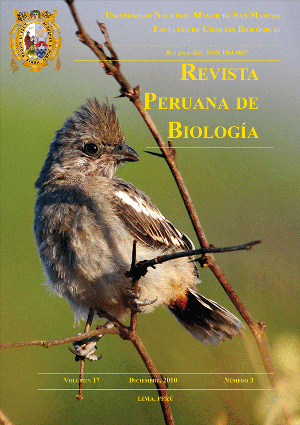Medicinal plants used in Peru for the treatment of respiratory disorders
DOI:
https://doi.org/10.15381/rpb.v17i3.8Keywords:
Ethnobotany, tradicional medicine, Peru, bronchitis, pneumonia, cold, cough, tuberculosis.Abstract
Respiratory tract infections continue to be a major health challenge worldwide especially due to the increasingly fast development of resistance to the drugs currently in use. Many plant species are traditionally used for respiratory illness treatment, and some have been investigated for their efficacy with positive results. A total of 91 plant species belonging to 82 genera and 48 families were documented and identified as respiratory system herbal remedies in Northern Peru. Most species used were Asteraceae (15 species, 16.67%), followed by Lamiaceae and Fabaceae (8.89% and 5.56%). The majority of respiratory disorder herbal preparations were prepared from the leaves of plants (27.69%), while the whole plant (18.46%), flowers (13.85%) and stems (17.69%) were used less frequently. In almost 55% of the cases fresh plant material was used to prepare remedies. About 86% of the remedies were applied orally, while the remaining ones were applied topically. Over half of all remedies were prepared as mixtures of multiple ingredients. Almost 50% of the plants found in the respiratory pharmacopoeia of Northern Peru, or their congeners have been studied for their medicinal properties. The results of this study show that both indigenous and introduced species are used for the treatment of respiratory system disorders. The information gained on frequently used traditional remedies might give some leads for future targets for further analysis in order to develop new drugs.Downloads
Downloads
Published
Issue
Section
License
Copyright (c) 2010 Rainer W. Bussmann, Ashley Glenn

This work is licensed under a Creative Commons Attribution-NonCommercial-ShareAlike 4.0 International License.
AUTHORS RETAIN THEIR RIGHTS:
a. Authors retain their trade mark rights and patent, and also on any process or procedure described in the article.
b. Authors retain their right to share, copy, distribute, perform and publicly communicate their article (eg, to place their article in an institutional repository or publish it in a book), with an acknowledgment of its initial publication in the Revista Peruana de Biologia.
c. Authors retain theirs right to make a subsequent publication of their work, to use the article or any part thereof (eg a compilation of his papers, lecture notes, thesis, or a book), always indicating its initial publication in the Revista Peruana de Biologia (the originator of the work, journal, volume, number and date).






